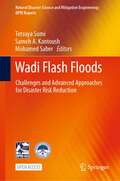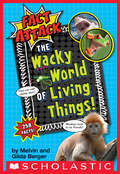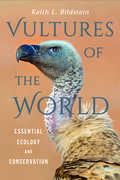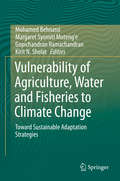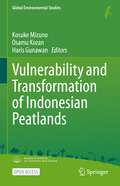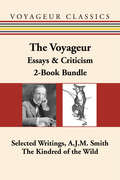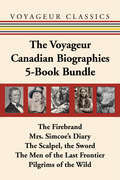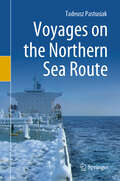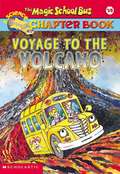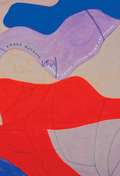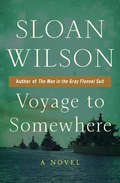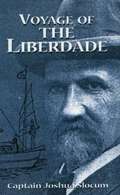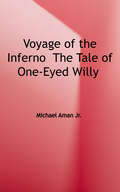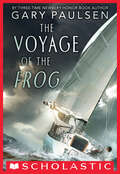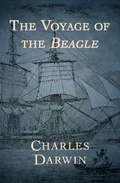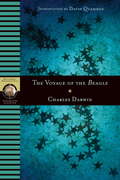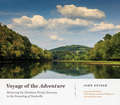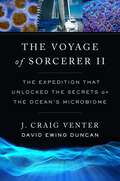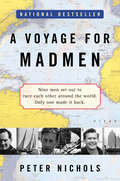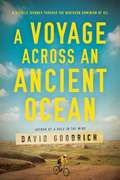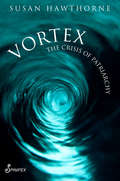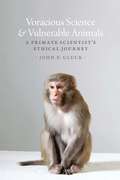- Table View
- List View
Wadi Flash Floods: Challenges and Advanced Approaches for Disaster Risk Reduction (Natural Disaster Science and Mitigation Engineering: DPRI reports)
by Tetsuya Sumi Sameh A. Kantoush Mohamed SaberThis open access book brings together research studies, developments, and application-related flash flood topics on wadi systems in arid regions. The major merit of this comprehensive book is its focus on research and technical papers as well as case study applications in different regions worldwide that cover many topics and answer several scientific questions. The book chapters comprehensively and significantly highlight different scientific research disciplines related to wadi flash floods, including climatology, hydrological models, new monitoring techniques, remote sensing techniques, field investigations, international collaboration projects, risk assessment and mitigation, sedimentation and sediment transport, and groundwater quality and quantity assessment and management. In this book, the contributing authors (engineers, researchers, and professionals) introduce their recent scientific findings to develop suitable, applicable, and innovative tools for forecasting, mitigation, and water management as well as society development under seven main research themes as follows: Part 1. Wadi Flash Flood Challenges and Strategies Part 2. Hydrometeorology and Climate Changes Part 3. Rainfall–Runoff Modeling and Approaches Part 4. Disaster Risk Reduction and Mitigation Part 5. Reservoir Sedimentation and Sediment Yield Part 6. Groundwater Management Part 7. Application and Case Studies The book includes selected high-quality papers from five series of the International Symposium on Flash Floods in Wadi Systems (ISFF) that were held in 2015, 2016, 2017, 2018, and 2020 in Japan, Egypt, Oman, Morocco, and Japan, respectively. These collections of chapters could provide valuable guidance and scientific content not only for academics, researchers, and students but also for decision-makers in the MENA region and worldwide.
The Wacky World of Living Things! (Fact Attack Ser.)
by Melvin Berger Gilda BergerThis is the first book in a brand-new series featuring TONS of awesomely incredible, weird, and crazy facts!Did you know crickets have ears on their knees? That snakes never close their eyes? Or that no plant has black flowers? Discover these incredible facts and more in the first Fact Attack book, all about plants and animalsFact Attack is an exploration of the most amazing and awe-inspiring plant and animal facts. Heavily designed with different approaches on each page, the style is dynamic, fresh, and in your face. Whether you flip to a page to learn a digestible fact or read it from beginning to end, this is a book a reader will return to time and again.
Wacky Weather for Walter (Read and Roll)
by Amy ParadisWalter is driving to his sister's house across town. With plenty of Wacky Weather for Walter in store, will he make it there in one piece?
Vultures of the World: Essential Ecology and Conservation
by Keith L. BildsteinIn Vultures of the World, Keith L. Bildstein provides an engaging look at vultures and condors, seeking to help us understand these widely recognized but underappreciated birds. Bildstein's latest work is an inspirational and long overdue blend of all things vulture. Based on decades of personal experience, dozens of case studies, and numerous up-to-date examples of cutting-edge science, this book introduces readers to the essential nature of vultures and condors. Not only do these most proficient of all vertebrate scavengers clean up natural and man-made organic waste but they also recycle ecologically essential elements back into both wild and human landscapes, allowing our ecosystems to function successfully across generations of organisms. With distributions ranging over more than three-quarters of all land on five continents, the world's twenty-three species of scavenging birds of prey offer an outstanding example of biological diversity writ large. Included in the world's species fold are its most abundant large raptors—several of its longest lived birds and the most massive of all soaring birds. With a fossil record dating back more than fifty million years, vultures and condors possess numerous adaptions that characteristically serve them well but at times also make them particularly vulnerable to human actions. Vultures of the World is a truly global treatment of vultures, offering a roadmap of how best to protect these birds and their important ecology.
Vultures (Nature's Children)
by Tim HarrisWhere do vultures live? What do vultures eat? How big are vultures? Find out the answers to these questions and learn all about vultures physical characteristics, behavior, and habitats.
Vulnerability of Agriculture, Water and Fisheries to Climate Change
by Mohamed Behnassi Margaret Syomiti Muteng'E Gopichandran Ramachandran Kirit N. ShelatHuman activity is changing the global environment at an unprecedented rate while humanity faces a range of complex and interrelated challenges to local, regional and global development, human security and politics. Food security ranks high on the science, policy and development agendas. However, most research linking global change and food systems examines the impact of climate change on agricultural production, or the impact of agriculture on land use, pollution and biodiversity, overlooking interactions with other aspects of the food system - such as food processing, packaging, transportation and consumption and employment derived from these activities. This book demonstrates that new threats to food security which arise from environmental change require more than simply a focus on agricultural practices - what is needed is an integrated food system approach. The authors point out that the process of adapting food systems to global environmental change is not simply a search for technological solutions to increase agricultural yields. Tradeoffs across multiple scales among food system outcomes are a prevalent feature of globalized food systems. Within food systems, there are key underexplored areas that are both sensitive to environmental change and crucial to understanding its implications for food security and adaptation strategies. The authors assert that technical prescriptions alone will not efficiently manage the food security challenge. This book is their contribution to a new paradigm, which addresses food systems holistically by engaging researchers in multiple disciplines to understand the causes and drivers of vulnerability.
Vulnerability and Transformation of Indonesian Peatlands (Global Environmental Studies)
by Kosuke Mizuno Osamu Kozan Haris GunawanThis open access book deals with restoring degraded peatlands to help mitigate global warming, to which SDG 15 and SDG 13 are directly related. The book analyzes peatland degradation and restoration of the Indonesian peatland ecosystem through the integrated lens of resilience, vulnerability, adaptation, and transformation. It sheds light on what constitutes "resilience" of the peat swamp forest, digs deeper into local knowledge in developing the studies on institutions, governance, and ecological conditions that support the resilience of the peat swamp forest to elaborate on the idea of transformation in today's degraded peatlands. While peat swamp forests may be resilient, they remain highly vulnerable. The book analyzes restoration efforts through rewetting, revegetation, and rehabilitation of the local livelihoods with the concepts of adaptation and transformation. The integrated analysis covers fieldwork of more than a decade and various aspects such as agrarian and social changes, biological changes (birds, mammals, and termites), carbon emission, water control, timber use, revegetation efforts, and the Indonesia Sustainable Palm Oil (ISPO) program implementation. It also employs the ideas of vulnerability, resilience, adaptability, and transformation based on expanded studies on peatlands and observations of and participation in multiple efforts to prevent fires and restore the degraded peatland by researchers, the government, non-government organizations (NGOs), private companies, and last but not least, the local people. The discussion includes the period of pre-degradation and several efforts at peatland restoration for a better understanding and analysis of the long-term peatland dynamics.
The Voyageur Canadian Essays & Criticism 2-Book Bundle: Selected Writings, A.J.M. Smith / The Kindred of the Wild
by A.J.M. Smith Michael Gnarowski Charles G. Roberts James PolkVoyageur Classics is a series of new versions of Canadian classics, with added material and special introductions. In this bundle we find two classic works of the art of the Canadian essay. Charles G.D. Roberts was a distinguished writer of his time who published more than forty volumes of poetry, romance fiction, and nature writing – making him one of the most popular writers of his time. He pioneered the animal story in which he went beyond surface elements of nature and endowed his animal "characters" with qualities of feeling and intelligence that brought them closer to their human cousins. Roberts’ career as a writer transcended his Canadian roots and he was internationally known and popular in America and England. Arthur James Marshall Smith – prize-winning poet, essayist, influential anthologist, and critic – died in 1980. His last book, The Classic Shade: Selected Poems, on which Selected Writings is based, stands as his final intention in the world of literature. To this long out of print book the editor has added original material by Smith in which he defined and advanced modernism in Canadian writing. Includes Selected Writings, A.J.M. Smith The Kindred of the Wild
The Voyageur Canadian Biographies 5-Book Bundle: The Firebrand / Mrs. Simcoe's Diary / The Scalpel, the Sword / The Men of the Last Frontier / Pilgrims of the Wild
by Grey Owl James Polk Michael Gnarowski Hugh Eayrs Julie Allan Norman Bethune Allan Susan Ostrovsky Sydney Gordon Mary Quayle Innis Elizabeth Posthuma Simcoe William Kilbourn Ronald StaggVoyageur Classics is a series of special versions of Canadian classics, with added material and new introductory notes. In this bundle we find five biographical and autobiographical titles that shed light on some of Canada’s most important figures at crucial times in the country’s development. William Kilbourn brings to life the rebel Canadian hero William Lyon Mackenzie: able political editor, first mayor of Toronto, and the gadfly of the House of Assembly. The Scalpel, the Sword celebrates the turbulent career of Dr. Norman Bethune, a brilliant surgeon, campaigner for socialized medicine, and communist. Elizabeth Simcoe’s diary, describing Canada from 1791 to 1796, is history written as it was being made, an account instilled with excitement and delight. And finally, two titles by the legendary Grey Owl tell his own astonishing story and advocate for a closeness with and respect for nature. Each of these books is an essential classic of Canadian literature. Includes The Firebrand Mrs. Simcoe’s Diary The Scalpel, the Sword The Men of the Last Frontier Pilgrims of the Wild
Voyages on the Northern Sea Route
by Tadeusz PastusiakThis book explains vessels’ ability to overcome ice on the Northern Sea Route, as well as the criteria of safe speed and maneuvering of vessels on ice. It provides a successful long-term forecast of ice navigation and reveals the dangers of sailing on the Northern Sea Route, It includes tips on how to plan and schedule voyages in the Russian Arctic. The book develops a set of suggested routes for the period of opening and closing of the transit ice-free zone through the NSR based on the last eleven navigation seasons. It presents a method for determining the date for beginning a voyage of a vessel without ice strengthening through the NSR. It also develops a model of initial (long-term) and operational decision-making support system for vessel voyage planning and scheduling. The main audience for the book are officers at operational and management level of competency, people planning voyages on the Northern Sea Route in the office of ship operator and in chartering department or consulting company, and participants of Ice Navigator IMO Model Courses at basic and advanced level of competency.
Voyage to the Volcano (The Magic School Bus Ser. #Vol. 15)
by Judith Stamper John SpeirsGet ready for some serious science fun when the Friz takes the kids on an explosive journey into the heart of a volcano! Hi, I'm Dorothy Ann, one of the kids in Ms. Frizzle's class. When we started learning about volcanoes, I thought we'd just be studying them in books -- but Ms. Frizzle had other ideas. She took us all the way to Hawaii, where we waded through lava and saw a real volcano blow its top. We had a great time -- even though the trip was sometimes almost too hot to handle! One thing's for sure: This was one explosive adventure that none of us will ever forget! Lexile Measure: 680L
A Voyage to the Island of the Articoles
by Andre Maurois"Dangerous, charming, and funny, this elegant miniature rediscovery will delight even brilliant minds."-Simon Van BooyAndré Maurois' novella, published in the same year as Margaret Mead's Coming of Age in Samoa, is about a couple who become shipwrecked on an uncharted South Seas Island and discover a race of literary zealots for whom every subject and feeling needs to be expressed as a form of literary art. As explained by Alberto Manguel, "An Articole will publish not only his Intimate Journal, but also his Journal of My Intimate Journal; and his wife will publish My Husband's Journal of His Intimate Journal."
Voyage to Somewhere: A Novel
by Sloan WilsonFrom the bestselling author of The Man in the Gray Flannel Suit, a World War II novel that is as thrilling as it is true to life Hoping to draw a nice, lengthy shore duty after two years at sea, Lieutenant Barton is instead told that he is being sent right back out, this time as captain of a supply ship sailing from California to New Guinea and stopping at every small island in between. Homesick for his wife, he has no choice but to accept the assignment and a crew of twenty-six landlubbers whose last names all begin with W. Their first load of cargo? Pineapples destined for Hawaii. Life aboard the one-hundred-eighty-foot SV-126 is never dull. When Barton isn't battling gale-force winds and monstrous waves, he is coping with seasick sailors and budding rivalries that threaten to turn mutinous. Hanging over the ship like a storm cloud is the knowledge that the world is at war and the enemy is never far away. Whether Lieutenant Barton and his crew are fighting torpedoes and typhoons or writing letters to loved ones, Voyage to Somewhere offers a unique and page-turning perspective on what the Second World War was really like.
Voyage of the Liberdade
by Joshua SlocumIn 1890, the author became the first person to circumnavigate the globe alone. This is the account of one of his lesser-known but no less remarkable sea journeys. From the Publisher: Great 19th-century mariner's thrilling, account of the wreck of his ship off the coast of South America, the 35-foot brave little craft he built from the wreckage, and its remarkable, danger-fraught voyage home. A 19th-century maritime classic brimming with courage, ingenuity, and daring. Easy-to-read and fast-paced.
Voyage of the Inferno: The Tale of One-Eyed Willy: A Prequal to The Goonies
by C. Michael Aman Jr.This book embarks on the life of an outlaw after being wrongfully accused of a crime he did not commit. Although raised in the Catholic Christian faith, he is plunged into a world of crime, murder, war and thievery. Even when he rises to be the commander of a pirate vessel, he still struggles to maintain his humanity. This is the tale of One-Eyed Willy and his enriching piratical endeavors in the first half of the 17th century.
The Voyage of the Frog (Piper Ser.)
by Gary PaulsenAn adventure novel about survival at sea from the Newbery Award–winning author of Northwind. “An epic, often lyrical journey of self-discovery.” —Kirkus Reviews (starred review)ALA/YALSA Best Book for Young Adults ALA Notable Book for ChildrenALA/YALSA Quick Pick for Reluctant Young Adult ReadersDavid thought he was alone, that the ocean around him was all there was of the world. The wind screamed, the waves towered, and his boat, the twenty-two foot fiberglass FROG, skidded and bucked and, each moment, filled deeper and grew heavier with sea water.David thought surely he was dead at fourteen. His uncle Owen, who had taught him about sailing safely, would be so angry. Owen had died only days ago, his last wish for David to take the FROG out on his own, and sail her beyond sight of the coast, and once there, scatter Owen’s ashes.David had done this the evening before, but he hadn’t thought of a storm roaring across the Pacific, or of the terror of being alone later in the dark hundreds of miles from home with no radio or flares and little food. He hadn’t thought of a shark attacking, or of the four killer whales, or the oil tanker large as a city about to sink him and the FROG . . . But in fact, David wasn’t alone at all. He’d had the FROG as a partner from the first—his uncle’s guiding spirit. He had only to learn that.“Paulsen’s spare prose offers an affecting blend of the boy’s inner thoughts and keen observations of the power of nature to destroy and to heal.” —School Library Journal
The Voyage of the Beagle: Journal Of Researches Into The Natural History And Geology Of The Countries Visited During The Voyage Of H. M. S. Beagle Round The World
by Charles DarwinThe riveting firsthand account of the historic voyage that led to the theory of evolution When the HMS Beagle set sail in 1831, the science of biology was not far removed from the Dark Ages. When the ship returned to England nearly five years later, Charles Darwin had the makings of a theory that would revolutionize our understanding of the natural world. From volcanoes in the Galapagos to the coral reefs of Australia, The Voyage of the Beagle documents the young naturalist's encounters with some of the earth's most stunning features. Darwin's observations of the people, places, and events he experienced make for compelling reading and offer a fascinating window into the intellectual development of his ideas about natural selection. A brilliant travelogue and a revealing glimpse into the Victorian mindset, The Voyage of the Beagle is an indispensable companion volume to On the Origin of Species. This ebook has been professionally proofread to ensure accuracy and readability on all devices.
The Voyage of the Beagle
by Charles Darwin David QuammenWhen HMS Beagle sailed out of Devonport on 27 December 1831, Charles Darwin was twenty-two and setting off on the voyage of a lifetime. His journal, here reprinted in a shortened form, shows a naturalist making patient observations concerning geology, natural history, people, places and events. Volcanoes in the Galapagos, the Gossamer spider of Patagonia and the Australasian coral reefs - all are to be found in these extraordinary writings. The insights made here were to set in motion the intellectual currents that led to the most controversial book of the Victorian age: The Origin of Species. Includes introduction by David Quammen and notes.
Voyage of the Beagle
by David Quammen Charles DarwinCharles Darwin's theory of evolution and natural selection has been debated and disparaged over time, but there is no dispute that he is responsible for some of the most remarkable and groundbreaking scientific findings in history. His five-year trip as a naturalist on the H.M.S. Beagle took him on a journey to such exotic locales as Chile, Argentina, and the Galapagos Islands. Darwin wrote the details of this expedition, including his thoughts about the people on the ship and of course, his observations of the flora and fauna, in his journal, published as Voyage of the Beagle. It is here that his original interpretations of the Galapagos ecosystem and the impact of nature and selection are first revealed.
Voyage of the Adventure: Retracing the Donelson Party's Journey to the Founding of Nashville
by John GuiderIn the harsh winter of 1779, as the leader of a flotilla of settlers, John Donelson loaded his family and thirty slaves into a forty-foot flatboat at the present site of Kingsport, Tennessee. Their journey into the wilderness led to the founding of a settlement now known as Nashville—over one thousand river miles away. In the fall of 2016, photographer John Guider retraced the Donelson party's journey in his hand-built fourteen-and-a-half-foot motorless rowing sailboat (named Adventure II after Donelson's boat) while making a visual documentation of the river as it currently exists 240 years later. This photo book contains more than 120 striking images from the course of the journey, allowing the reader to see how much has changed and how much has remained untouched in the two and a half centuries since Donelson first took to the water. Equally significant, the essays include long-ignored contemporary histories of both the Cherokee whom Donelson encountered and the slaves he brought with him, some of whom did not survive the journey. From his platform just a few feet above the waterline, Guider, a professional photographer, created images of the thousand-mile trip along three of Tennessee's most notable rivers.
The Voyage of Sorcerer II: The Expedition That Unlocked the Secrets of the Ocean’s Microbiome
by J. Craig Venter David Ewing Duncan“Will undoubtedly shape our understanding of the global ecosystem for decades to come.”—Siddhartha Mukherjee, author of The Emperor of All MaladiesA celebrated genome scientist sails around the world, collecting tens of millions of marine microbes and revolutionizing our understanding of the microbiome that sustains us.Upon completing his historic work on the Human Genome Project, J. Craig Venter declared that he would sequence the genetic code of all life on earth. Thus began a fifteen-year quest to collect DNA from the world’s oldest and most abundant form of life: microbes. Boarding the Sorcerer II, a 100-foot sailboat turned research vessel, Venter traveled over 65,000 miles around the globe to sample ocean water and the microscopic life within.In The Voyage of Sorcerer II, Venter and science writer David Ewing Duncan tell the remarkable story of these expeditions and of the momentous discoveries that ensued—of plant-like bacteria that get their energy from the sun, proteins that metabolize vast amounts of hydrogen, and microbes whose genes shield them from ultraviolet light. The result was a massive library of millions of unknown genes, thousands of unseen protein families, and new lineages of bacteria that revealed the unimaginable complexity of life on earth. Yet despite this exquisite diversity, Venter encountered sobering reminders of how human activity is disturbing the delicate microbial ecosystem that nurtures life on earth. In the face of unprecedented climate change, Venter and Duncan show how we can harness the microbial genome to develop alternative sources of energy, food, and medicine that might ultimately avert our destruction.A captivating story of exploration and discovery, The Voyage of Sorcerer II restores microbes to their rightful place as crucial partners in our evolutionary past and guides to our future.
A Voyage For Madmen: Nine Men Set Out To Race Each Other Around The World. Only One Made It Back ...
by Peter NicholsIn 1968, nine sailors set off on the most daring race ever held: to single-handedly circumnavigate the globe nonstop. It was a feat that had never been accomplished and one that would forever change the face of sailing. Ten months later, only one of the nine men would cross the finish line and earn fame, wealth, and glory. For the others, the reward was madness, failure, and death. In this extraordinary book, Peter Nichols chronicles a contest of the individual against the sea, waged at a time before cell phones, satellite dishes, and electronic positioning systems. A Voyage for Madmen is a tale of sailors driven by their own dreams and demons, of horrific storms in the Southern Ocean, and of those riveting moments when a split-second decision means the difference between life and death.
A Voyage Across an Ancient Ocean: A Bicycle Journey Through the Northern Dominion of Oil
by David GoodrichIn the face of widespread misinformation and misunderstanding, a climate scientist ventures into the vast heart of America&’s new oil country on just two wheels.Recently recovered from his epic bicycle journey that took him from the Delaware shore to the Oregon coast, distinguished climate scientist David Goodrich sets out on his bike again to traverse the Western Interior Seaway—an ancient ocean that once spread across half of North America. When the waters cleared a geologic age ago, what was left behind was vast, flat prairie, otherworldly rock formations, and oil shale deposits. As Goodrich journeys through the Badlands and Theodore Roosevelt National Park and across the prairies of the upper Midwest and Canada, we get a raw and ground-level view of where the tar sands and oil reserves are being opened up at an incredible and unprecedented pace. Extraordinary and unregulated, this &“black goldrush&” is boom and bust in every sense. In a manner reminiscent of John McPhee and Rachel Carson, combined with Goodrich&’s wry self-deprecation and scientific expertise, A Voyage Across an Ancient Ocean is a galvanizing and adventure-filled read that gets to the heart of drilling on our continent.
Vortex: The Crisis of Patriarchy
by Susan HawthorneDo we want to live in a world without birdsong? The pesticides, the coal mines, the clear-felling forestry industry, the industrial farmers are destroying the earth with their insistence on profit. But what point is profit on a dead and silent planet?In this enlightening yet devastating book, Susan Hawthorne writes with clarity and incisiveness on how patriarchy is wreaking destruction on the planet and on communities. The twin mantras of globalisation and growth expounded by the neoliberalism that has hijacked the planet are revealed in all their shabby deception. Backed by meticulous research, the author shows how so-called advances in technology are, like a Trojan horse, used to mask sinister political agendas that sacrifice the common good for the shallow profiteering of corporations and mega-rich individuals.The biotechnologists see the lure of cure, rising share prices and profits.She details how women, lesbians, people with disabilities, Indigenous peoples, the poor, refugees and the very earth itself are being damaged by the crisis of patriarchy that is sucking everyone into its vortex. Importantly, this precise and insightful volume also shows what is needed to get ourselves out of this spiral of destruction: a radical feminist approach with compassion and empathy at its core.Shame is an emotion of the powerless because they cannot change the rules.The book shows a way out of the vortex: it is now up to the collective imagination and action of people everywhere to take up the challenges Susan Hawthorne shows are needed. This is a vital book for a world in crisis and should be read by everyone who cares about our future.
Voracious Science and Vulnerable Animals: A Primate Scientist's Ethical Journey
by John P. GluckThe National Institute of Health recently announced its plan to retire the fifty remaining chimpanzees held in national research facilities and place them in sanctuaries. This significant decision comes after a lengthy process of examination and debate about the ethics of animal research. For decades, proponents of such research have argued that the discoveries and benefits for humans far outweigh the costs of the traumatic effects on the animals; but today, even the researchers themselves have come to question the practice. John P. Gluck has been one of the scientists at the forefront of the movement to end research on primates, and in Voracious Science and Vulnerable Animals he tells a vivid, heart-rending, personal story of how he became a vocal activist for animal protection. Gluck begins by taking us inside the laboratory of Harry F. Harlow at the University of Wisconsin, where Gluck worked as a graduate student in the 1960s. Harlow's primate lab became famous for his behavioral experiments in maternal deprivation and social isolation of rhesus macaques. Though trained as a behavioral scientist, Gluck finds himself unable to overlook the intense psychological and physical damage these experiments wrought on the macaques. Gluck's sobering and moving account reveals how in this and other labs, including his own, he came to grapple with the uncomfortable justifications that many researchers were offering for their work. As his sense of conflict grows, we're right alongside him, developing a deep empathy for the often smart and always vulnerable animals used for these experiments. At a time of unprecedented recognition of the intellectual cognition and emotional intelligence of animals, Voracious Science and Vulnerable Animals is a powerful appeal for our respect and compassion for those creatures who have unwillingly dedicated their lives to science. Through the words of someone who has inflicted pain in the name of science and come to abhor it, it's important to know what has led this far to progress and where further inroads in animal research ethics are needed.
